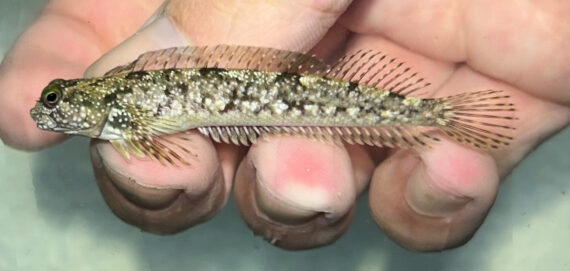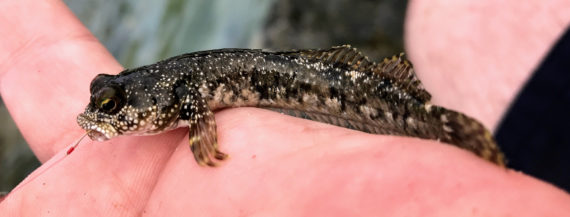Foureye Rockskipper, Dialommus macrocephalus

 Foureye Rockskipper, Dialommus macrocephalus. Fish caught off the Playa Flamingo, Guanacaste, Costa Rica, December 2024. Length: 7.6 cm (3.0 inches). Catch, photograph, and identification courtesy of James Lafontaine, Long Island, New York.
Foureye Rockskipper, Dialommus macrocephalus. Fish caught off the Playa Flamingo, Guanacaste, Costa Rica, December 2024. Length: 7.6 cm (3.0 inches). Catch, photograph, and identification courtesy of James Lafontaine, Long Island, New York.
 Foureye Rockskipper, Dialommus macrocephalus. Fish caught off the Playa Blanca, Herradua, Costa Rica, June 2017. Length: 9.5 cm (3.7 inches). Catch, photograph, and identification courtesy of Ryan Crutchfield, Tampa, Florida.
Foureye Rockskipper, Dialommus macrocephalus. Fish caught off the Playa Blanca, Herradua, Costa Rica, June 2017. Length: 9.5 cm (3.7 inches). Catch, photograph, and identification courtesy of Ryan Crutchfield, Tampa, Florida.
The Foureye Rockskipper, Dialommus macrocephalus, is a member of the Labrisomid Blenny or Labrisomidae Family, and is known in Mexico as trambollo listo. Globally, there are two species in the genus Dialommus, of which one is found in Mexican waters, this species from the Pacific Ocean.
The Foureye Rockskipper has an elongated body that has a uniform depth throughout before tapering gradually at the rear into the tail. They are dark gray with light and dark mottling. They have small white spots on their head, pectoral fin base, and upper back. Their head is black, large, and without cirri. They have mid-sized eyes set very high on their head. They have a fairly large and slightly oblique terminal mouth. Their teeth are set in narrow bands. Their anal fin has 2 short fleshy spines and 24 rays; and, their dorsal fin has 22 spines and 12 or 13 rays and is deeply notched. They are covered with small smooth scales.
The Foureye Rockskipper is a benthic shallow water intertidal species that can been seen shuttling back and forth in rocky tidal pools at depths up to 5 m (18 feet). They reach a maximum of 11.0 cm (4.3 inches) in length. They feed on invertebrates and small crabs. They have the ability to breathe air and can survive up to four hours out of water in damp environments. Reproduction is oviparous with external fertilization. The Foureye Rockskipper is poorly studied with very limited information available about their lifestyle and behavioral patterns including specific details on age, growth, longevity, movement patterns, diet, habitat use, and reproduction.
The Foureye Rockskipper is a resident of Mexican waters of the Pacific Ocean but has a limited distribution being found within the coastal waters in the greater Cabo San Lucas area, Baja California Sur and from Puerto Vallarta, Jalisco, southward along the coast of the mainland to Guatemala.
The Foureye Rockskipper can be confused with the Notchfin Blenny, Entomacrodus chiostictus (sparse white spotting covering body).
From a conservation perspective the Foureye Rockskipper is currently considered to be of Least Concern with stable, widely distributed populations. They are exceedingly prone to the destruction of their coastal habitat environment resulting from coastal development. They are small in stature and of limited interest to most.